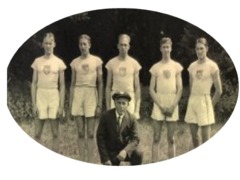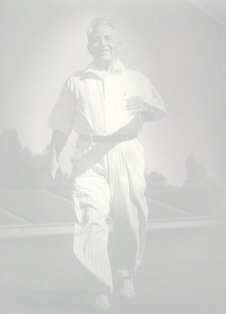 Amos
Alonzo Stagg was born to a poor family in the town of West Orange, New
Jersey, on August 16, 1862. At the time, the nation was engaged in a
bitterly fought civil war. The years following that war proved to be
difficult ones for the Stagg family. As a result, while still a young
and growing boy, “Lonnie” as Stagg was called, had to work to help his
father provide for the family. He earned meager wages running errands,
carrying buckets of ashes, cutting the threshing grain by hand for
farmers around the salt meadows of Newark and chopping wood. It was
hard work and usually meant laboring many hours each day. Fortunately,
when Lonnie was a young boy, life was not all work and no play. Early
in his boyhood, he enjoyed hard play and competition. He loved to
participate in games requiring physical prowess, stamina and skill. One
game, of the soccer type, was played with balls from blown-up pig
bladders, which Lonnie’s father, after butchering hogs each fall, would
give to him. Usually the games involved a lot of rough action. The
long hours of hard work and participation in rough, competitive games
did much to help Lonnie develop a strong body. At the time, Lonnie and
his boyhood friends knew very little about the game of football. He was
only seven years of age when, in 1869, the first intercollegiate game
was played between Rutgers and Princeton. However, as time was to
eventually reveal, it would be from his years of association with
football, as a player and coach, that he would achieve recognition and
greatness. While football and fame were waiting in the wings for Stagg,
he became keenly interested in playing the game of baseball. Although
he played first and third base, Lonnie liked to pitch best. He
practiced diligently for many hours to improve his pitching skills.
Opposing batters had difficulty hitting his combination of pitches and
by the time he graduated from Orange High School, Orange, New Jersey,
Lonnie had become an outstanding pitcher. Numerous home, educational,
athletic and religious experiences during Lonnie’s childhood and young
adult life positively influenced the development of his code of ethics
and character. In his parents’ home, because of their poverty, he
learned about the virtues of self-discipline, sacrifice, hard work and
honesty. Early in his life, he became aware of the necessity of a good
education and he strived to attain one. He was able to achieve a high
school and college education through hard work, sacrifice and
perseverance. When he was in high school, he became a member of the
First Presbyterian Church of Orange, New Jersey. Undoubtedly, accepting
the teachings and moral principles of his religion greatly influenced
Lonnie’s attitude toward living a highly moral life. In high school
athletics, principally baseball, he developed a keen sense of loyalty,
fair play and sportsmanship. Lonnie Stagg, upon his graduation from high
school in 1883, had a fervent desire to continue his education. He
chose to attend Yale University, which maintains an excellent reputation
as an educational institution. It had a divinity school, which was
important to Lonnie, for he wanted to become a Presbyterian minister.
Already strongly driven to extend his education, he received additional
motivation from others. Amos Alonzo Stagg, Jr., in later years said his
father’s decision to attend Yale was strongly influenced by his sister,
his Sunday school teacher and the minister of his church.
Amos
Alonzo Stagg was born to a poor family in the town of West Orange, New
Jersey, on August 16, 1862. At the time, the nation was engaged in a
bitterly fought civil war. The years following that war proved to be
difficult ones for the Stagg family. As a result, while still a young
and growing boy, “Lonnie” as Stagg was called, had to work to help his
father provide for the family. He earned meager wages running errands,
carrying buckets of ashes, cutting the threshing grain by hand for
farmers around the salt meadows of Newark and chopping wood. It was
hard work and usually meant laboring many hours each day. Fortunately,
when Lonnie was a young boy, life was not all work and no play. Early
in his boyhood, he enjoyed hard play and competition. He loved to
participate in games requiring physical prowess, stamina and skill. One
game, of the soccer type, was played with balls from blown-up pig
bladders, which Lonnie’s father, after butchering hogs each fall, would
give to him. Usually the games involved a lot of rough action. The
long hours of hard work and participation in rough, competitive games
did much to help Lonnie develop a strong body. At the time, Lonnie and
his boyhood friends knew very little about the game of football. He was
only seven years of age when, in 1869, the first intercollegiate game
was played between Rutgers and Princeton. However, as time was to
eventually reveal, it would be from his years of association with
football, as a player and coach, that he would achieve recognition and
greatness. While football and fame were waiting in the wings for Stagg,
he became keenly interested in playing the game of baseball. Although
he played first and third base, Lonnie liked to pitch best. He
practiced diligently for many hours to improve his pitching skills.
Opposing batters had difficulty hitting his combination of pitches and
by the time he graduated from Orange High School, Orange, New Jersey,
Lonnie had become an outstanding pitcher. Numerous home, educational,
athletic and religious experiences during Lonnie’s childhood and young
adult life positively influenced the development of his code of ethics
and character. In his parents’ home, because of their poverty, he
learned about the virtues of self-discipline, sacrifice, hard work and
honesty. Early in his life, he became aware of the necessity of a good
education and he strived to attain one. He was able to achieve a high
school and college education through hard work, sacrifice and
perseverance. When he was in high school, he became a member of the
First Presbyterian Church of Orange, New Jersey. Undoubtedly, accepting
the teachings and moral principles of his religion greatly influenced
Lonnie’s attitude toward living a highly moral life. In high school
athletics, principally baseball, he developed a keen sense of loyalty,
fair play and sportsmanship. Lonnie Stagg, upon his graduation from high
school in 1883, had a fervent desire to continue his education. He
chose to attend Yale University, which maintains an excellent reputation
as an educational institution. It had a divinity school, which was
important to Lonnie, for he wanted to become a Presbyterian minister.
Already strongly driven to extend his education, he received additional
motivation from others. Amos Alonzo Stagg, Jr., in later years said his
father’s decision to attend Yale was strongly influenced by his sister,
his Sunday school teacher and the minister of his church.
However, Lonnie soon learned that his high school
education had not adequately prepared him to pass the entrance exams at
Yale. Therefore, he found it necessary to attend, for one year,
Phillips Exeter Academy, a college preparatory school for boys, located
in Exeter, New Hampshire. The 1883-84 school year at Phillips Exeter
Academy was a hard one for Lonnie. He found that wages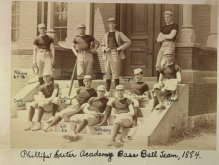 earned during the previous summer cutting hay in the salt meadows were
barely sufficient for him to pay Exeter’s tuition and still have enough
remaining for room and food. He overcame the financial burden by
following a strict budget. (Picture right - Mr. Stagg was
part of the 1884 Phillips Exeter Academy Baseball Team.)
earned during the previous summer cutting hay in the salt meadows were
barely sufficient for him to pay Exeter’s tuition and still have enough
remaining for room and food. He overcame the financial burden by
following a strict budget. (Picture right - Mr. Stagg was
part of the 1884 Phillips Exeter Academy Baseball Team.)
In the fall of 1884, he entered Yale University. At Yale, Lonnie didn’t have enough money to provide for room and board. After paying the $29.80 tuition fee for entrance into Yale’s divinity school, he had only a small amount of money left. For the first three months at Yale, in an attempt to conserve his money, he decided upon a daily diet that consisted of soda crackers or stale bread and a quart of milk. He lived in a small, unheated room, which cost him one dollar a week. A short time after school began, he was able to find a job sweeping out the school’s chapel. However, the little wages received were not enough to stop the steady drain on his small money supply. One day Lonnie became ill with a fever and chills. A doctor diagnosed his illness as resulting from malnutrition. His daily diet simply was not providing his body with the needed nutrition. With the help of friends, Lonnie soon found a job waiting on tables at one of the school’s student dining halls. His situation began to improve. Also, he began to receive additional help from other members of his family, one of whom was a sister who had attended Vassar College. Amos Alonzo Stagg, Jr., commented that during those critical years of decision-making and commitment, his father received much encouragement and help from her. Later, one of his professors, upon learning of Lonnie Stagg’s hardships, gave him board (meals) for doing various chores around his home. These turns in fortune helped him nourish his body back to full strength. He felt more secure about completing college. In the spring of his freshman year, he tried out for the University’s freshman baseball team. He had no difficulty, as a third base man, making the team. He was such an outstanding player that he was soon promoted to the varsity team. However, as he had at Orange High School, Lonnie wanted to pitch. He got his opportunity to pitch when it was learned that Yale’s star pitcher was throwing the ball so hard and fast that no one on the team could catch his pitches. A decision was made to make the hard throwing pitcher the catcher and let Stagg Pitch. The decision was to change the baseball fortunes of both Stagg and Yale for the next five years. In his five years of playing baseball at Yale, for rules of eligibility then permitted an athlete to participate in his postgraduate year, Stagg pitched the team to five successive championships.
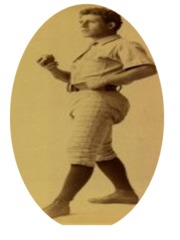 (Picture
Left - Mr. Stagg on Yale Baseball Team) Amos Alonzo Stagg’s skill and
success as a college pitcher impressed the talent scouts of various
major league baseball teams. In his senior year, six big league
baseball teams offered him a contract. The New York Nationals, later
called the Giants, offered Stagg $4,200 for one season of play. He
refused all of the professional team contracts. He did so for a number
of reasons. First, he strongly believed that games were best played in
the spirit of amateurism. He disliked the thought of anyone playing
sports for a salary. Second, big league ball parks of the era contained
saloons and some of the professional athletes at the time were of
questionable character. His moral standards would not permit him to
play in such an environment. No amount of money could have enticed him
to play professionally. Money was unimportant to Lonnie Stagg, as
shown by numerous examples. He was content to live on the modest salary
of a college professor. In his later years, a Hollywood film producing
company wanted to make a movie about his illustrious career and life.
They offered him a large sum of money for his permission to make the
movie. He refused their offer. He explained to family members that he
believed it wasn’t proper to have his personal and professional life
portrayed on film. “Incidentally,” he said to his family, “if I had
signed a movie contract, I wouldn’t have kept any of the money. I would
have given it to Yale and the University of Chicago.” On another
occasion, he refused a three hundred dollar afternoon speaking
engagement because it conflicted with his team’s scheduled football
practice.
(Picture
Left - Mr. Stagg on Yale Baseball Team) Amos Alonzo Stagg’s skill and
success as a college pitcher impressed the talent scouts of various
major league baseball teams. In his senior year, six big league
baseball teams offered him a contract. The New York Nationals, later
called the Giants, offered Stagg $4,200 for one season of play. He
refused all of the professional team contracts. He did so for a number
of reasons. First, he strongly believed that games were best played in
the spirit of amateurism. He disliked the thought of anyone playing
sports for a salary. Second, big league ball parks of the era contained
saloons and some of the professional athletes at the time were of
questionable character. His moral standards would not permit him to
play in such an environment. No amount of money could have enticed him
to play professionally. Money was unimportant to Lonnie Stagg, as
shown by numerous examples. He was content to live on the modest salary
of a college professor. In his later years, a Hollywood film producing
company wanted to make a movie about his illustrious career and life.
They offered him a large sum of money for his permission to make the
movie. He refused their offer. He explained to family members that he
believed it wasn’t proper to have his personal and professional life
portrayed on film. “Incidentally,” he said to his family, “if I had
signed a movie contract, I wouldn’t have kept any of the money. I would
have given it to Yale and the University of Chicago.” On another
occasion, he refused a three hundred dollar afternoon speaking
engagement because it conflicted with his team’s scheduled football
practice.
(Picture Left - Amos Alonzo Stagg posing with the 1924 Olympics Track Team in Paris, France. He was the coach.)
He was known to be generous with his money, often bringing track athletes to the Olympic Games at his expense. He purchased, for three thousand dollars, a 40-acre tract of land as a gift at the College of the Pacific for development into athletic fields. He gave one thousand dollars to the University of Chicago for the placement of chimes in one of its buildings - - chimes which would, on a given evening hour, signal bedtime for its athletes.
Lonnie Stagg didn’t play much football at Yale until
1887, his junior year. He did not play as a regular before then because
the baseball schedule carried over into the football season. Also, the
baseball team feared that a football injury could cost it the loss of
its star pitcher.
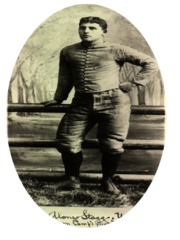 The
conflict between the two sport schedules continued to limit his
participation in football until the 1889 season, when he played
regularly at the right end position. Enroute to winning the conference
championship, the 1889 Yale football team won 15 games and lost one.
Stagg, because of his outstanding play at right end, was selected by
Caspar Whitney and Walter Camp to be on the roster of the first
All-American football team.
The
conflict between the two sport schedules continued to limit his
participation in football until the 1889 season, when he played
regularly at the right end position. Enroute to winning the conference
championship, the 1889 Yale football team won 15 games and lost one.
Stagg, because of his outstanding play at right end, was selected by
Caspar Whitney and Walter Camp to be on the roster of the first
All-American football team.
(Picture Right - Amos Alonzo Stagg - 1888 Yale Football Team)
While at Yale, Lonnie learned that he was not very effective as a public speaker. He had difficulty addressing audiences at Christian meetings, conferences and camps. Feeling that a successful minister must be able to speak effectively to large groups and at the time lacking such an ability, he decided to withdraw from Yale’s divinity school. However, he was determined to spread his Christian ideals to others. He decided that if he couldn’t do so as a minister, he would accomplish the goal on the athletic field as a coach.
In 1890, he entered the International Y.M.C.A. College at Springfield, Massachusetts. He was preparing to become a physical education teacher and coach. At the Y.M.C.A. College, Stagg was quickly recognized, not only for his athletic skill and moral character, but also for his genius as a young coach. He formed and coached the college’s first football team. He and his teams were respected by opponents for their hard, fair play and sportsmanship, which became a trademark of all future Stagg coached teams.
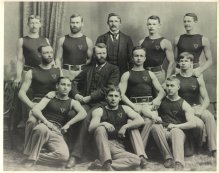
(Image Left - Mr. Stagg's 1891 YMCA Graduating Class)
Click here for a very large image.

(List of 1891 YMCA Graduating Class Members)
Click here for large image. Click here for a very large image.
James Naismith, the inventor of basketball, in 1891,
was a classmate of Stagg’s at the Y.M.C.A. College. It is a little
known fact that Amos Alonzo Stagg had a hand in the creation of
basketball. Before introducing his new game, James Naismith discussed
its various facets with Stagg. Amos Alonzo Stagg, Jr., said his father
was to have played in the very first game of basketball, but was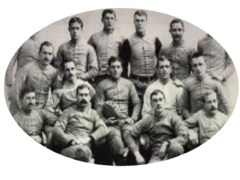 unable to do so because of a previously scheduled speaking engagement.
(Picture Right - Y.M.C.A. College 1891 Football team. James Naismith is
bottom row, second from left. ) In 1890, while still a student at
the Y.M.C.A. College and in addition to playing with and coaching the
College’s teams, Stagg was persuaded to coach the football teams of
Williston Seminary, in Easthampton, Massachusetts. It was the first
coaching job for which he received pay. However, his schedule at the
Y.M.C.A. College and the traveling distance to Easthampton limited his
coaching at Williston Seminary to one day a week. Nevertheless, he did
a good job, considering the limitations and, in 1891, was offered a
second contract to coach the Seminary team. By 1892, the knowledge of
Lonnie Stagg’s inventiveness and genius as a coach, as well as his
gentlemanly qualities had become widely known. Dr. William Rainey
Harper, president of the newly formed University of
unable to do so because of a previously scheduled speaking engagement.
(Picture Right - Y.M.C.A. College 1891 Football team. James Naismith is
bottom row, second from left. ) In 1890, while still a student at
the Y.M.C.A. College and in addition to playing with and coaching the
College’s teams, Stagg was persuaded to coach the football teams of
Williston Seminary, in Easthampton, Massachusetts. It was the first
coaching job for which he received pay. However, his schedule at the
Y.M.C.A. College and the traveling distance to Easthampton limited his
coaching at Williston Seminary to one day a week. Nevertheless, he did
a good job, considering the limitations and, in 1891, was offered a
second contract to coach the Seminary team. By 1892, the knowledge of
Lonnie Stagg’s inventiveness and genius as a coach, as well as his
gentlemanly qualities had become widely known. Dr. William Rainey
Harper, president of the newly formed University of
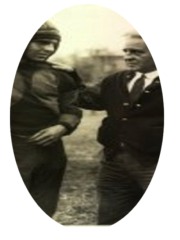 Chicago,
desired a man of Stagg’s stature to become the director of the new
university’s Department of Physical Culture and Athletics. He persuaded
Lonnie to come to the Midwest university and assigned him the rank of
Associate Professor. Such an academic rating for an athletic coach was
unheard of in that era. Stagg’s association with the University of
Chicago was to last for the next 41 years. During Stagg’s years at the
University of Chicago, its athletic program developed into one of the
nation’s best. In football, it became nationally recognized as a
powerhouse. Always well-coached, its teams were known for their hard
play and sportsmanship, as well as the crafty offensive and defensive
formations demonstrated each game. Lonnie Stagg, as coach, was like a
magician. Opponents never knew what to expect. He invented numerous
offensive and defensive formations, many of which are still used today.
Chicago,
desired a man of Stagg’s stature to become the director of the new
university’s Department of Physical Culture and Athletics. He persuaded
Lonnie to come to the Midwest university and assigned him the rank of
Associate Professor. Such an academic rating for an athletic coach was
unheard of in that era. Stagg’s association with the University of
Chicago was to last for the next 41 years. During Stagg’s years at the
University of Chicago, its athletic program developed into one of the
nation’s best. In football, it became nationally recognized as a
powerhouse. Always well-coached, its teams were known for their hard
play and sportsmanship, as well as the crafty offensive and defensive
formations demonstrated each game. Lonnie Stagg, as coach, was like a
magician. Opponents never knew what to expect. He invented numerous
offensive and defensive formations, many of which are still used today.
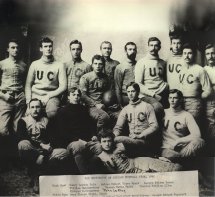 His
University of Chicago teams won 225 games, losing 113 and tying 27. In
addition to coaching football at the University, Stagg coached track and
field for 32 years, baseball for 19 years and basketball for one year.
His
University of Chicago teams won 225 games, losing 113 and tying 27. In
addition to coaching football at the University, Stagg coached track and
field for 32 years, baseball for 19 years and basketball for one year.
Image Left - University of Chicago Football Team 1892
View Large Image
View Larger Image
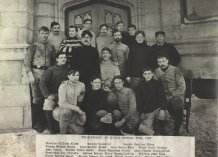
Image Left - University of Chicago Football Team 1893
View Large Image View Larger Image
At age 70, because of university policy, Stagg was
forced into retirement. He wanted to remain at the University of
Chicago but realized that he could not. Still in good health and
desiring to continue coaching, he found a job as head coach at the
College of the Pacific in Stockton, California. He coached there for
the next fourteen years. Three of his College of the
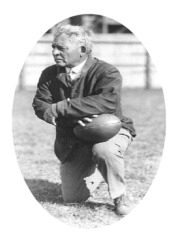 Pacific teams won
the Far Western Conference Championship. The small college, which
previously was unknown to many, now received nationwide publicity. In
1943, a year in which his Tigers won 7 and lost 2, the Football Coaches
Association honored him by voting Lonnie as “Coach of the Year.” At the
time he was 81 years of age.
Pacific teams won
the Far Western Conference Championship. The small college, which
previously was unknown to many, now received nationwide publicity. In
1943, a year in which his Tigers won 7 and lost 2, the Football Coaches
Association honored him by voting Lonnie as “Coach of the Year.” At the
time he was 81 years of age.
Stagg, at age 84, left the College of the Pacific. He went back east and joined his son, Amos Alonzo Stagg, Jr., the coach at Susquehanna University, located in Selinsgrove, Pennsylvania. While Stagg was at Susquehanna, the University, in 1951, had its first unbeaten and untied season. He was listed, officially, as an advisory coach to his son. In later years, his son stated that his father handled all of the duties and responsibilities of a head coach and that he, Stagg, Jr., actually served as an assistant coach. The statement was supported by a number of athletes who played on the Susquehanna teams during Lonnie’s stay at the university. Amos Alonzo Stagg, Jr., contends that his father should be credited with the 21 games won during those years at Susquehanna. However, A.A. Stagg, Jr’s., contention notwithstanding, the National Collegiate Athletic Association (NCAA) would not credit Lonnie with the Susquehanna victories but only with those victories number 314 wherein he was listed officially as the head coach.
During the 1981 football season, Bear Bryant, coach of
the University of Alabama football team, won his 315th game and
succeeded Amos Alonzo Stagg as the “winningest football coach” in the
game’s history. However, had the NCAA credited Stagg with the games won
at Susquehanna, he would have a total of 335 victories. In 1952, at age
90, because of his wife, Stella’s, failing health,
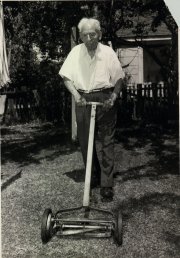 he
left Susquehanna University and returned to their home in Stockton.
From the time of their marriage on September 10, 1892, she had been
Lonnie’s constant companion and “assistant coach.” Stella Stagg
observed, year after year, many of the practice sessions and was present
at most of the games. She kept game statistics, scouting forms and
helped answer, daily, the large volume of mail addressed to Coach
Stagg. He felt now that his place must be near to her. However, once
he returned to Stockton, Lonnie found some time each afternoon in the
fall to work with the Stockton Junior College kickers and punters. He
was, until age 97, an “advisory coach” on the school’s football staff.
It was Lonnie’s last coaching assignment. (Image left - Mr.
Stagg mowing his lawn at age 98.)
he
left Susquehanna University and returned to their home in Stockton.
From the time of their marriage on September 10, 1892, she had been
Lonnie’s constant companion and “assistant coach.” Stella Stagg
observed, year after year, many of the practice sessions and was present
at most of the games. She kept game statistics, scouting forms and
helped answer, daily, the large volume of mail addressed to Coach
Stagg. He felt now that his place must be near to her. However, once
he returned to Stockton, Lonnie found some time each afternoon in the
fall to work with the Stockton Junior College kickers and punters. He
was, until age 97, an “advisory coach” on the school’s football staff.
It was Lonnie’s last coaching assignment. (Image left - Mr.
Stagg mowing his lawn at age 98.)
President John F. Kennedy, on the occasion of Amos
Alonzo Stagg’s 100th birthday, wrote this tribute. “His character and
career have been an inspiration since his undergraduate days for
countless Americans. Few men in our history have set so persuasive and
shining examples as a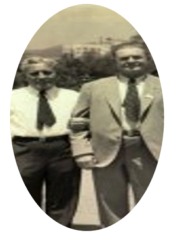 teacher, coach and citizen. His integrity and dedication to all the
goals he has set for himself are unmatched.” The “Grand Old Man of
Football,” as Lonnie for years was affectionately called, lived to an
age just five months short of his 103rd birthday. (Image
Right - 1932, Mr. Stagg and Pop Warner, Hollywood, California)
teacher, coach and citizen. His integrity and dedication to all the
goals he has set for himself are unmatched.” The “Grand Old Man of
Football,” as Lonnie for years was affectionately called, lived to an
age just five months short of his 103rd birthday. (Image
Right - 1932, Mr. Stagg and Pop Warner, Hollywood, California)
Dr. Robert E. Burns, when President of the University
of the Pacific and the Amos Alonzo Stagg Foundation, Inc., said, “Ever a
participant rather than a spectator, Amos Alonzo Stagg, through
scholarships, playing fields, schools bearing his name and other
perpetual awards made possible by his thousands of admirers, will be
forever in the minds of young and old. The rare example of his life - -
his philosophy, his sportsmanship, his countless achievements through
physical and moral fitness, will inspire Americans in the years ahead.”
“ . . . .
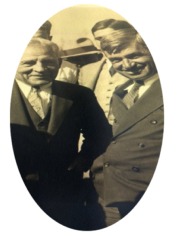 THERE
NEVER WAS A MAN OF STAGG’S STATURE IN U.S. SPORTS, AND THERE NEVER WILL
BE AGAIN.” Author, Bob Considine
THERE
NEVER WAS A MAN OF STAGG’S STATURE IN U.S. SPORTS, AND THERE NEVER WILL
BE AGAIN.” Author, Bob Considine
(Image Left - Mr. Stagg and Will Rogers - 1934)
This biography is a publication of the Amos Alonzo Stagg Special Collection Committee. The committee wishes to especially thank Mr. Dominic Bertinetti Jr., Chairman of the Special Collection Committee, for his tireless efforts in making this biography and the assembling of the materials in the Amos Alonzo Stagg High School Stagg archives. This biography was prepared by Mr. Bertinetti drawing from these resources. All pictures are taken from the Amos Alonzo Stagg Special Collection. The pictures were donated by members of the Amos Alonzo Stagg family to the Special Collection residing at Amos Alonzo Stagg High School, Palos Hills, Illinois. Clicking on any picture will show a larger view of that picture.
